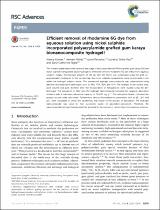 ResearchSpace
ResearchSpace
Efficient removal of rhodamine 6G dye from aqueous solution using nickel sulphide incorporated polyacrylamide grafted gum karaya bionanocomposite hydrogel
JavaScript is disabled for your browser. Some features of this site may not work without it.
- ResearchSpace
- →
- Research Publications/Outputs
- →
- Journal Articles
- →
- View Item
| dc.contributor.author |
Kumar, Neeraj

|
|
| dc.contributor.author |
Mittal, Hemmant

|
|
| dc.contributor.author |
Parashar, V

|
|
| dc.contributor.author |
Ray, Suprakas S

|
|
| dc.contributor.author |
Ngila, JC

|
|
| dc.date.accessioned | 2017-05-16T10:10:23Z | |
| dc.date.available | 2017-05-16T10:10:23Z | |
| dc.date.issued | 2016-02 | |
| dc.identifier.citation | Kumar, N., Mittal, H., Parashar, V. et al. 2016. Efficient removal of rhodamine 6G dye from aqueous solution using nickel sulphide incorporated polyacrylamide grafted gum karaya bionanocomposite hydrogel. RSC Advances, vol. 6: 21929-21939 | en_US |
| dc.identifier.issn | 2046-2069 | |
| dc.identifier.uri | http://pubs.rsc.org/en/content/articlelanding/2016/ra/c5ra24299a#!divAbstract | |
| dc.identifier.uri | DOI: 10.1039/c5ra24299a | |
| dc.identifier.uri | http://hdl.handle.net/10204/9042 | |
| dc.description | © The Royal Society of Chemistry 2016 | en_US |
| dc.description.abstract | This research paper reports the synthesis and usage of the polyacrylamide (PAAm) grafted gum karaya (Gk) and nickel sulphide nanoparticle based hydrogel to effectively remove rhodamine 6G dye (R6G) from aqueous solution. Initially, the hydrogel polymer of the Gk with the PAAm was synthesized using the graft co-polymerization technique. In the second step, the nickel sulphide nanoparticles were incorporated in situ within the hydrogel polymer matrix. The synthesized hydrogel nanocomposite was characterized using different characterization techniques such as XRD, FTIR, SEM, and TEM. The changes in the surface area, pore volume and pore diameter after the incorporation of nanoparticles were studied using the BET technique. The adsorption of R6G onto the hydrogel nanocomposite followed the Langmuir adsorption isotherm with a maximum adsorption capacity of 1244.71 mg g(sup-1). The adsorption kinetics followed the pseudo-second order rate model. Furthermore, various thermodynamic parameters such as S°, H° and G° were calculated to check the spontaneity and nature of the process of adsorption. The hydrogel nanocomposite was used for five successive cycles of adsorption–desorption. Therefore, the nanocomposite hydrogels have proved their potential for the removal of cationic dyes from aqueous solutions. | en_US |
| dc.language.iso | en | en_US |
| dc.publisher | Royal Society of Chemistry | en_US |
| dc.rights | CC0 1.0 Universal | * |
| dc.rights.uri | http://creativecommons.org/publicdomain/zero/1.0/ | * |
| dc.subject | Polyacrylamide | en_US |
| dc.subject | PAAm | en_US |
| dc.subject | Gum karaya | en_US |
| dc.subject | Gk | en_US |
| dc.subject | Nanoparticles | en_US |
| dc.title | Efficient removal of rhodamine 6G dye from aqueous solution using nickel sulphide incorporated polyacrylamide grafted gum karaya bionanocomposite hydrogel | en_US |
| dc.type | Article | en_US |
| dc.identifier.apacitation | Kumar, N., Mittal, H., Parashar, V., Ray, S. S., & Ngila, J. (2016). Efficient removal of rhodamine 6G dye from aqueous solution using nickel sulphide incorporated polyacrylamide grafted gum karaya bionanocomposite hydrogel. http://hdl.handle.net/10204/9042 | en_ZA |
| dc.identifier.chicagocitation | Kumar, Neeraj, Hemmant Mittal, V Parashar, Suprakas S Ray, and JC Ngila "Efficient removal of rhodamine 6G dye from aqueous solution using nickel sulphide incorporated polyacrylamide grafted gum karaya bionanocomposite hydrogel." (2016) http://hdl.handle.net/10204/9042 | en_ZA |
| dc.identifier.vancouvercitation | Kumar N, Mittal H, Parashar V, Ray SS, Ngila J. Efficient removal of rhodamine 6G dye from aqueous solution using nickel sulphide incorporated polyacrylamide grafted gum karaya bionanocomposite hydrogel. 2016; http://hdl.handle.net/10204/9042. | en_ZA |
| dc.identifier.ris | TY - Article AU - Kumar, Neeraj AU - Mittal, Hemmant AU - Parashar, V AU - Ray, Suprakas S AU - Ngila, JC AB - This research paper reports the synthesis and usage of the polyacrylamide (PAAm) grafted gum karaya (Gk) and nickel sulphide nanoparticle based hydrogel to effectively remove rhodamine 6G dye (R6G) from aqueous solution. Initially, the hydrogel polymer of the Gk with the PAAm was synthesized using the graft co-polymerization technique. In the second step, the nickel sulphide nanoparticles were incorporated in situ within the hydrogel polymer matrix. The synthesized hydrogel nanocomposite was characterized using different characterization techniques such as XRD, FTIR, SEM, and TEM. The changes in the surface area, pore volume and pore diameter after the incorporation of nanoparticles were studied using the BET technique. The adsorption of R6G onto the hydrogel nanocomposite followed the Langmuir adsorption isotherm with a maximum adsorption capacity of 1244.71 mg g(sup-1). The adsorption kinetics followed the pseudo-second order rate model. Furthermore, various thermodynamic parameters such as S°, H° and G° were calculated to check the spontaneity and nature of the process of adsorption. The hydrogel nanocomposite was used for five successive cycles of adsorption–desorption. Therefore, the nanocomposite hydrogels have proved their potential for the removal of cationic dyes from aqueous solutions. DA - 2016-02 DB - ResearchSpace DP - CSIR KW - Polyacrylamide KW - PAAm KW - Gum karaya KW - Gk KW - Nanoparticles LK - https://researchspace.csir.co.za PY - 2016 SM - 2046-2069 T1 - Efficient removal of rhodamine 6G dye from aqueous solution using nickel sulphide incorporated polyacrylamide grafted gum karaya bionanocomposite hydrogel TI - Efficient removal of rhodamine 6G dye from aqueous solution using nickel sulphide incorporated polyacrylamide grafted gum karaya bionanocomposite hydrogel UR - http://hdl.handle.net/10204/9042 ER - | en_ZA |
Files in this item
The following license files are associated with this item:






